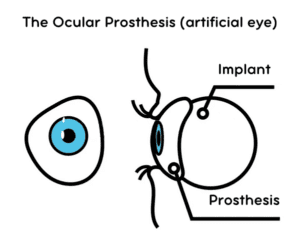Bizi Ara +90 324 238 83 83
Home »
Last updated on August 27th, 2024 at 12:38 am
Home »

Especially, Enucleation and Evisceration are terms of Prosthetic Eye Surgery that refer to surgery to remove the eye from the eye socket or orbit for the ocular prosthesis (artificial eye). Enucleation is the surgical removal of the entire eyeball, leaving behind the lining of the eyelids and eye muscles. Evisceration removes only the contents of the eye, leaving the white part of the eye (sclera) and eye muscles intact.
It is necessary to prepare the prosthesis before placing the prosthesis in the empty eye socket. Orbital implants and ocular molds place inside the eye are use to adapt to the tissue surrounding the eye to prepare the eye socket. Especially, the two-part orbital implant and ocular prosthesis system provides a stable and well-tolerated aesthetic restoration of the eye socket. By placing the orbital implant and ocular prosthesis, a natural appearance can be obtained even if vision cannot be achieved by removing the eye.
Also, orbital implants are spherical prostheses that are place behind the lining of the socket (conjunctiva) to replace the tissue volume lost when your eye is remove. Extra ocular muscles can be attach to the implant surface to prevent implant displacement and assist socket movement.
Especially, ocular molds are design for use after surgery to prevent closure or adhesions during the healing process. The adaptors are small, acrylic cup-shaped apparatuses whose inner surfaces are shaped approximately according to the curvature of the orbit. Mold use creates a significant clinical difference in patients. The molds will stay in place for 6 to 8 weeks as the eye socket heals and swelling decreases.
It is a type of prosthesis that replaces the natural eye that is not present after an enucleation, evisceration or orbital exonation. Accordingly, the prosthesis replaces the molds and fits over an orbital implant and under the eyelids.
Especially, the eye surgeon who will perform this surgery should specialize in the manufacture and fitting of ocular prostheses for people who have lost an eye or eye due to trauma or disease.
Particularly, after a serious injury, an eye may need to be remove an intra ocular tumor (tumors inside the eye), control pain in a blind eye, relieve a serious infection within the eye, or cosmetically improve a disfigured person.
Also, there may be other treatments available and your doctor will discuss these with you. If you think you need more information, please consult your doctor.
Especially, if you choose to ignore your eye, there can be several different outcomes. An intra ocular tumor may continue to grow or spread to other parts of the body, making treatment more difficult. Also, an infected eye can get worse and the infection can spread, making treatment and pain management difficult.
Enucleation is the procedure often use if the eye is remove to treat an intra ocular tumor, serious infection, or to reduce the risk of developing a serious autoimmune condition (called sympathetic ophthalmia) following trauma to the eye.
Evisceration is a less invasive procedure and may be an option depending on the condition of the eye to be operate on. Also, your surgeon will recommend the most suitable surgery for you.
Both surgeries are perform in the operating room and under general anesthesia. Especially, a ball-shaped spherical implant is place behind the conjunctival tissue in your socket to replace the tissue volume lost when your eye is remove. The implant material is silicone, plastic and porous implants such as Medpor (porous polyethylene), hydroxyapatite or bioceramic.
The implant can then be attach to the eye muscles to allow movement of the implant and the artificial eye when locate.
At the end of the surgery, a mold (thin plastic shell) will be place in the eye socket to help maintain the shape of the socket and reduce swelling.
Addition to that, you will be given anesthesia during the operation. Usually, This is effective in relieving pain within a few hours of surgery. After that, any pain is usually well controlled by pain relievers. Especially, the operation takes about one to two hours and you may need to stay in the hospital for 1 day after the operation.
Usually, a pressure bandage is put on to help with swelling. Especially, when it heals, your eye socket will look similar to the skin on the inside of your lip. Also, your tear function will not be affect and you will be able to open and close your eyelids normally when you have your artificial eye fit.
Before your surgery, your doctor will talk to you about your surgery. On the day of your surgery, our doctors will do some tests for you.
For more detailed information, you can make an appointment with our doctor.
What is Prosthetic Eye Surgery cost, Vitrectomy Surgeries, Periodic Eye Examinations.
Bizi Ara +90 324 238 83 83